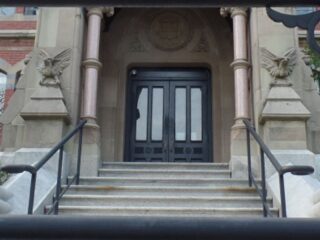by Terrell Dempsey
I have spent three delightful days in Hannibal, loitering around all day long, examining the old localities and talking with the grey-heads who were boys and girls with me 30 or 40 years ago.
~ Mark Twain to Livy, May 17, 1882
Any modern pilgrim seeking the real Mark Twain will find his Mecca in a little town nestled in Bear Creek Valley on the Mississippi River some 90 miles north of St. Louis. It was Hannibal, Missouri and the river that defines it, where Twain consistently re-returned in his literature. Tom Sawyer, a children’s book, Huckleberry Finn, from which Ernest Hemingway said, “All modern American literature comes,” and Puddn’head Wilson, perhaps Twain’s darkest novel, are all set in the time shortly before the Civil War in a Missouri river town modeled on Hannibal.
Before he was Mark Twain, of course, he was Samuel Clemens, son of John Marshall and Jane Lampton Clemens. He was born in 1835, just 20 miles west of Hannibal, in the little town of Florida, Missouri much of which now lies gurgling beneath the waters of Mark Twain Lake. In 1839, after one of his father’s many business failures and death of a sister, Sam’s family moved to Hannibal for yet another in a long line of new beginnings. Sam called the river town home until 1853 when he set out to explore the east as a traveling journeyman printer.
Samuel Clemens and Slavery
When Sam lived in Hannibal, one of every four people in the little town was a slave thus creating a bustling human market. Some dozen slave traders have been identified and perhaps another two dozen bought and sold flesh here in the 1840s and 1850s when the cotton belt exploded. Not surprisingly, and fortunately for American literature, the problem of runaway slaves was a major issue in Sam Clemens’ Hannibal.
The state of Missouri was a peninsula of slavery thrust into free territory. Today’s visitor can stand on the riverfront of Hannibal and gaze across the water to Illinois. That was hostile territory in 1839. Illinois swarmed with abolitionists who would aid runaway slaves to freedom. In 1841 Sam’s father served on a jury that convicted three white Illinois men who had come into the county in an attempt to free slaves. The Mississippi River was more than an avenue of commerce at the time–it was the Berlin Wall of its day.
Due east of Hannibal in the middle of the river is Jackson’s Island where the fictional Huck took flight and encountered the runaway slave Jim. It was also just beyond that island in a slough near the Illinois shore that the real Sam Clemens and his friends discovered the body of a dead runaway slave. Sam was fishing when they found the body in a snag. They pulled it loose and it floated headfirst to the surface.
Meanwhile in Old Baptist Cemetery on the eastern side of Cardiff Hill is a stone engraved, “Agness Flautleroy – Slave of Sophia Hawkins Died July 16, 1855.” The only marked slave grave in Hannibal, the stone marks the resting spot of a slave who took care of Sam’s neighbor Laura Hawkins who was the model for Becky Thatcher. Next to Agness’ stone is a homemade concrete marker from the post-civil war era. It is lightly engraved, “Petunia.” This grave most likely contains the daughter of Agness, who was the slave of Laura Hawkins from childhood.
Mark Twain Emerges
Of course, Twain’s literary career actually began in Hannibal. When his father died in 1847, Sam was just 11 years old. His impoverished mother apprenticed him to Joseph Ament who published the Missouri Courier in 1848. It was there Sam learned to set type and compose articles. In 1850 Sam’s brother Orion started a newspaper called the Western Union and in a short time Sam went to work for him. Sam Clemens first known article humorous, of course, appeared in the Western Union on January 16, 1851, called A Gallant Fireman.
The Clemens brothers published the newspaper for a time in the parlor of the little house known as the Mark Twain Boyhood Home and operated as a museum. The house is one of two of the places occupied by Sam’s family that still exists in Hannibal. Widowed Mrs. Clemens rented beds here to boarders for extra income. Sam’s sister Pamela gave piano lessons. It must have been a lively household. While the press was in the parlor, a cow wandered in one night, ate two composition rollers and knocked over a case of type.
Another Clemens family dwelling lies above Grant’s Drugstore. Located at this address are the apartments where the family wintered after one of John Marshall Clemens’ many business failures. The family furniture and goods had been sold to pay creditors yet the same boards and steps which young Sam climbed remain for touring.
Twain returned to Hannibal briefly in 1861 at the outset of the Civil War and took to the field with a ragtag band of Missouri Militia sworn to serve both the State of Missouri and the federal government. While Twain forever obscured the actual history of what transpired in the week or two he was a soldier, it is clear that he decided that prudence was better than patriotism. As Missouri disintegrated into a bloody civil war, he hightailed it to the safety of the Southwest. There he served as the unpaid, but safe, secretary to his brother Orion who was appointed by Lincoln as secretary to the governor of the Nevada Territory.
Mark Twain traveled the world and explored exotic places from the huts of Polynesia to the castles of Europe, but at the very center of his being he carried the little town of Hannibal.








